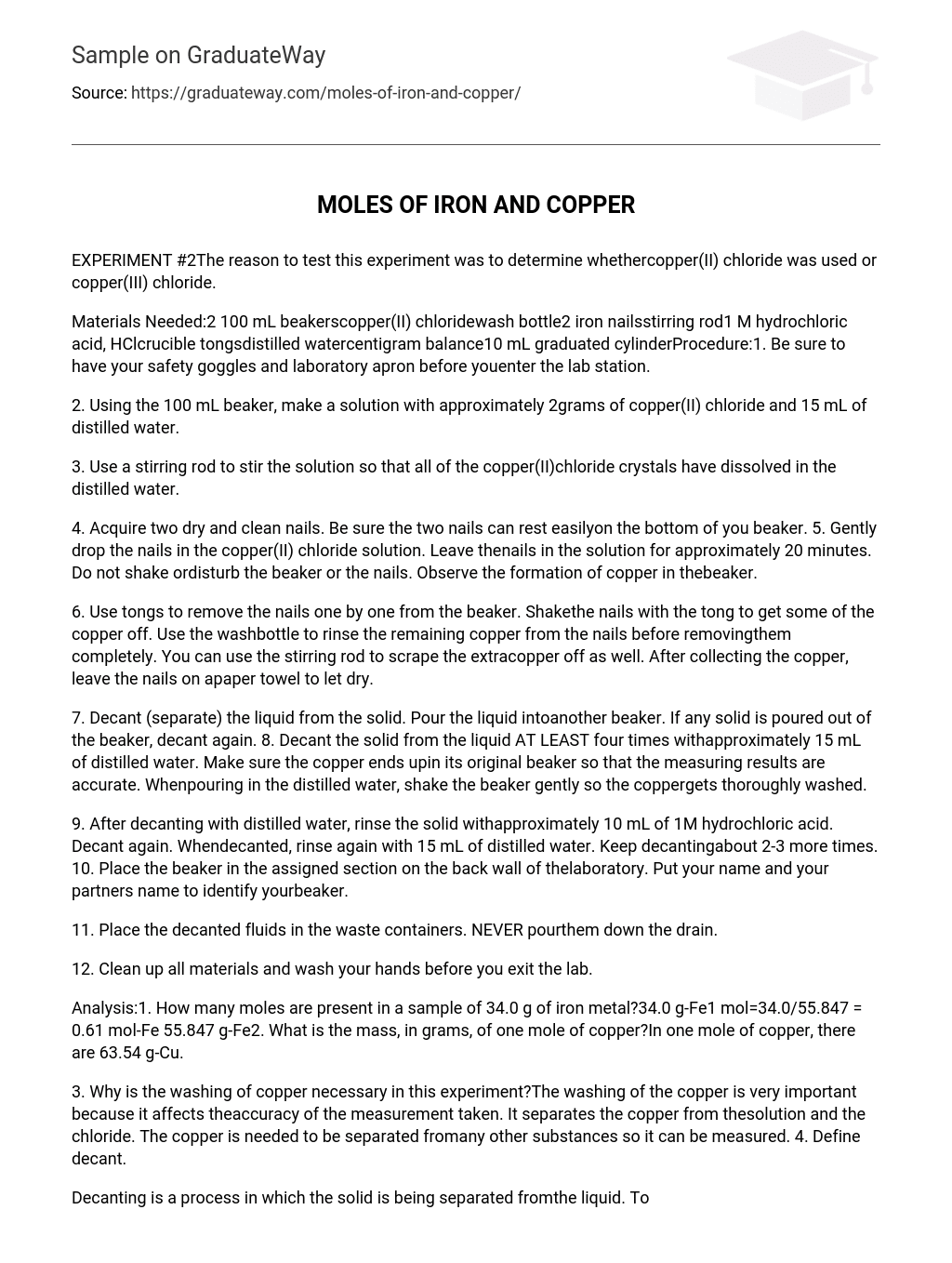EXPERIMENT
The reason to test this experiment was to determine whethercopper(II) chloride was used or copper(III) chloride.
Materials Needed: 100 mL beakerscopper(II) chloridewash bottle 2 iron nailsstirring rod1 M hydrochloric acid, HClcrucible tongsdistilled watercentigram balance10 mL graduated cylinderProcedure:
- Be sure to have your safety goggles and laboratory apron before youenter the lab station.
- Using the 100 mL beaker, make a solution with approximately 2grams of copper(II) chloride and 15 mL of distilled water.
- Use a stirring rod to stir the solution so that all of the copper(II)chloride crystals have dissolved in the distilled water.
- Acquire two dry and clean nails. Be sure the two nails can rest easilyon the bottom of you beaker.
- Gently drop the nails in the copper(II) chloride solution. Leave thenails in the solution for approximately 20 minutes. Do not shake ordisturb the beaker or the nails. Observe the formation of copper in thebeaker.
- Use tongs to remove the nails one by one from the beaker. Shakethe nails with the tong to get some of the copper off. Use the washbottle to rinse the remaining copper from the nails before removingthem completely. You can use the stirring rod to scrape the extracopper off as well. After collecting the copper, leave the nails on apaper towel to let dry.
- Decant (separate) the liquid from the solid. Pour the liquid intoanother beaker. If any solid is poured out of the beaker, decant again. 8. Decant the solid from the liquid AT LEAST four times withapproximately 15 mL of distilled water. Make sure the copper ends upin its original beaker so that the measuring results are accurate. Whenpouring in the distilled water, shake the beaker gently so the coppergets thoroughly washed.
- After decanting with distilled water, rinse the solid withapproximately 10 mL of 1M hydrochloric acid. Decant again. Whendecanted, rinse again with 15 mL of distilled water. Keep decantingabout 2-3 more times.
- Place the beaker in the assigned section on the back wall of thelaboratory. Put your name and your partners name to identify yourbeaker.
- Place the decanted fluids in the waste containers. NEVER pourthem down the drain.
- Clean up all materials and wash your hands before you exit the lab.
Analysis
How many moles are present in a sample of 34.0 g of iron metal?34.0 g-Fe1 mol=34.0/55.847 = 0.61 mol-Fe 55.847 g-Fe2.
What is the mass, in grams, of one mole of copper?In one mole of copper, there are 63.54 g-Cu.
Why is the washing of copper necessary in this experiment?The washing of the copper is very important because it affects theaccuracy of the measurement taken. It separates the copper from thesolution and the chloride. The copper is needed to be separated fromany other substances so it can be measured.
Define decant. Decanting is a process in which the solid is being separated fromthe liquid. To decant, the liquid should SLOWLY be poured into anotherbeaker, leaving the solid on the bottom of the original beaker. If someof the solid becomes transferred into the other beaker, the liquid needsto be poured back with the rest of the solid to avoid losing any of it.
How were you able to determine the mass of iron lost from thenail during the reaction?To determine the mass of the iron lost from the nail, I subtractedits mass before the reaction from its mass after the reaction.
Write the formula for iron(II) chloride and iron(III) chloride. iron(II) chloride = FeCl2iron(III) chloride = FeCl37. Based on the result of your experiment, which form of ironchloride was produced in this reaction? Explain. Iron(II) Chloride was used in the experiment. This is proven by theone-to-one molar ratio in the data table. Write and balance the chemical equation of this experiment. Besure to include the physical states of each of the reactants andproducts. Fe(s) + CuCl2(s)—>FeCl2(aq) + Cu(s)
Could the same reaction be obtained by reacting some smallpieces of copper with some iron chloride solution? Why or why not?No, it copper with iron chloride will not give the same reaction asiron with copper chloride. Due to single replacement, copper with ironchloride will have no reaction because the iron is more active than thecopper.
Why does the reaction of iron and copper chloride occur?The reaction occurs because iron is more active than copperchloride, therefore, it will react. To put this in other words, since theiron is more active than the copper chloride, the reaction will result in aswitch between the iron and copper because the iron is more favorable.
Based on what you have learned from this experiment, do youthink that a similar reaction would take place between zinc solid andlead nitrate solution? If yes, write and balance the chemicalequation. If no, then explain why. Zn + Pb(NO3)2 —>Zn(NO3)2 + PbZn11Pb11NO322
Conclusion
In this lab, iron with copper(II) chloride were experimented. Theproducts of these became iron(II) chloride and copper. It wasdetermined that iron(II) chloride was produced, not iron(III) chloride dueto the process of one-to-one molar ratio. The calculations on the datatable helped to determine this conclusion. But if the molar ratio wasone-to-three, then iron(III) chloride would be produced.
By following directions more and reading the procedurethoroughly, this lab would have been much better. This lab had to berepeated because the calculations on the data table did not match andthe measurements were not accurate enough. The decanting of the firstlab was very poor as well because the copper was not thoroughlyseparated from its other substance. The calculations were wrongbecause different beakers were measured in the place of one as well asthe mathwork being inaccurate.





